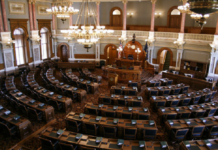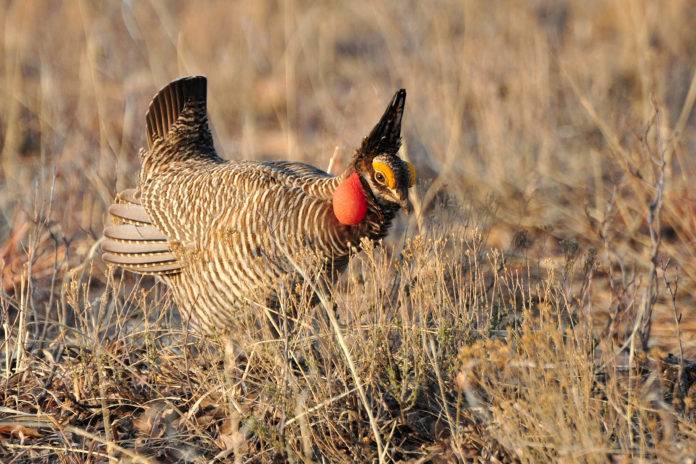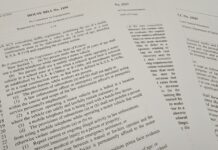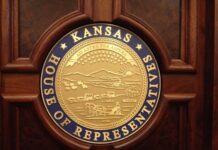Gov. Laura Kelly’s administration is urging the federal government not to impose new protections for the lesser prairie chicken, saying the states are in the best position to protect the bird’s habitat.
The Kansas Department of Wildlife and Parks told regulators in a Sept. 1 letter that the lesser prairie chicken didn’t warrant additional federal protections that would come with being listed as threatened under the Endangered Species Act.
“The available information does not indicate the species is ‘likely to become an endangered species within the foreseeable throughout all or a significant portion of its range,'” the Wildlife Secretary Brad Loveless wrote.
Loveless said a federal decision to step in and impose more protections – above and beyond what Kansas law already provides – would interfere with state efforts to protect the bird and breed distrust with landowners.
“Whether a listing is determined to be warranted or not, the state wildlife management agencies remain the best source of management authority and conservation actions” for the lesser pairie chicken, Loveless wrote to the agency.
The secretary said the U.S. Fish and Wildlife Service doesn’t have the staff in Kansas – or anywhere else for that matter – to do the work needed to preserve the bird’s habitat.
“State wildlife management agencies have the technical expertise and longstanding relationships with landowners that is necessary to accomplish the task of increasing habitat quality and reversing habitat loss trends,” Lovelesss wrote.
Extending new federal protections to the bird, he wrote, “will make these tasks more difficult due to mistrust and a lack of developed relationships with the landowners that are critical to the success of the species.”
In an interview, Loveless said the agency tries to develop relationships with landowners so it can encourage them to adopt conservation practices to protect the bird.
The state’s conservation efforts are hampered, he said, if the federal government gives the bird new protections.
“When a species gets listed, a lot of people don’t want to talk about it,” Loveless said.
“They are worried that that they may have a listed species on their property that may impair their ability to do their work and make a living,” he said.
The state’s letter was submitted as part of the comment period in which federal regulators sought feedback from their proposal to list the bird as “endangered” in parts of the country and “threatened” in other areas.
The lesser prairie chicken is a species of prairie grouse that occupies a five-state range including portions of Texas, New Mexico, Oklahoma, Kansas and Colorado.
Known for its feathered feet and stout build, the bird’s population has plummeted by 85% since the 1800s although the population has rebounded a little in recent year.
Loveless noted that the bird’s populaton across the five states is now estimated at about 33,000, up from an estimated 15,000 in 2013.

“Our numbers are well up from those lows in ’12 and ’13. We’re encouraged by that,” Loveless said.
“They’re still not up to the levels that the Fish and Wildlife Service is seeking. The important thing is they’re trending up,” he said.
The secretary said the state has been monitoring the lesser prairie chicken population since 1964, “creating one of the most extensive and robust datasets available for examining LPC population trends, habitat use and distribution.”
The data used by U.S. Fish and Wildlife to make its decision on whether to list the bird as protected comes from the five states within the bird’s range.
Loveless says in his letter that the federal government doesn’t consistently monitor the lesser pairie chicken’s population, meaning it must turn to the states and other federal agencies for information to conserve and manage the bird’s habitat.
Federal regulators are proposing to divide up the bird’s range in the midwest and southwest into areas where it would be considered “endangered” or “threatened.”
Fish and Wildlife is proposing to list the birds as “endangered” in eastern New Mexico and in the western part of the Texas panhandle where there are believed to be as few as 5,000 birds remaining, with the count dropping to as low as 1,000 birds in 2015.
The bird would be listed as “threatened” in Kansas, Oklahoma and Colorado.
The distinction between “endangered” and “threatened” is significant because of the regulations each could bring with it to the state’s economic development interests.
Federal regulations protect “endangered species” from being killed or harmed without federal authorization.
Regulators have more flexibility for “threatened species” where they can write rules requiring conservation efforts of any activity that might affect the bird’s habitat.
Loveless emphasized with federal regulators the need to exempt grazing from any new federal environmental protections that might be extended to the lesser prairie chicken.
While U.S. Fish and Wildlife has proposed exempting routine agriculture activities from the new protections, it didn’t carve out ranching, which Loveless said would have a distinct impact on Kansas.
“That set off alarm bells in the agriculture community in Kansas,” Loveless said.
“If they don’t grant that exemption, that whole community is really going to be concerned about how they can comply,” he said an interview.
The state says in its letter that is has played an important role in working to conserve the lesser prairie chicken’s habitat, including a first of it’s kind plan that not only detailed the threats to the bird but also provided funding for conservation efforts.
Loveless noted in his letter than an extra layer of protections would impede the state’s efforts to undertake its own conservation practices of the bird’s habitat.
“Everything we’d do would be more complex and more challenging as a result of a listing decision,” he said in an interview.
Republican Attorney General Derek Schmidt, who will most likely face Kelly in next year’s governor’s race, also agreed with the governor’s administration that the bird should not be listed as threatened.
Schmidt said federal regulators should consider voluntary actions to protect the species., noting that more than 2 million acres of habitat have been added in Kansas.
“Practical considerations weigh in favor of the agency not listing the lesser prairie chicken as a threatened species,” Schmidt wrote in a letter to Fish and Wildlife.
“The vast majority of the land within the known (lesser prairie chicken range) in Kansas is privately owned.
“Kansans have demonstrated that they care about the preservation of the lesser prairie chicken within the broader context of respect for private property rights, generational stewardship of the environment, and the state’s interests as a sovereign to fairly balance environmental and economic interests within its own borders.”
















